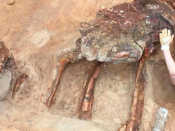Por Liliana Apolinário (LIP).
Abstract: It is believed that few millionths of a second after the Big Bang, the Universe was filled with a hot and dense matter - called the Quark-Gluon Plasma (QGP). This new state of matter, characterised by the deconfinement of the Quantum Chromodynamics (QCD) degrees of freedom - quarks and gluons - can be recreated in the laboratory through ultra-relativistic heavy-ion collisions. From such high energy interaction, the two nuclei “melt” into an almost perfect liquid: the QGP. As this evanescent medium expands and cools down, quarks and gluons recombine into normal hadronic matter. As such, only indirect observations from the resulting products of this interaction are possible. “Hard probes”, such as jets, that are produced within the collision, when crossing this strongly interacting matter, undergo energy loss phenomena that can be described within the perturbative regime of the QCD. The degree of such modifications - generically called jet quenching - can reveal the QGP properties, and ultimately, constrain the early evolution of our Universe.






















